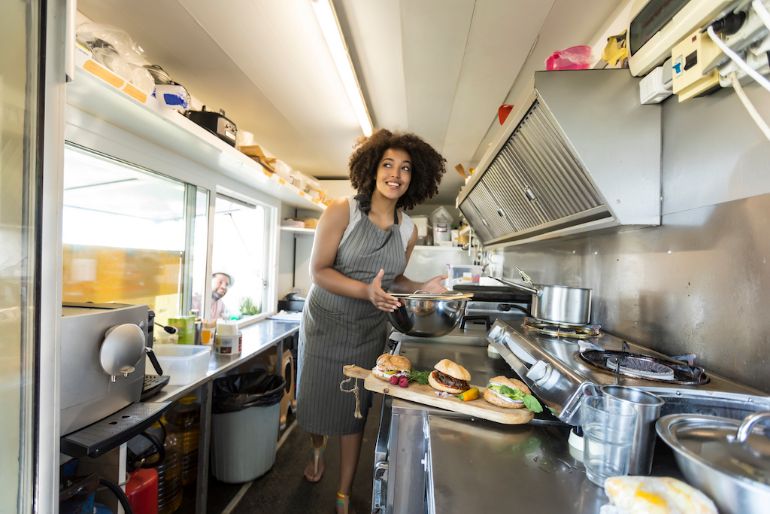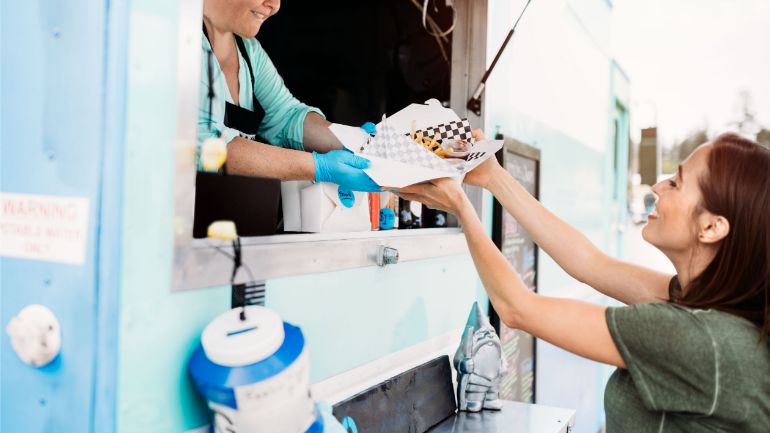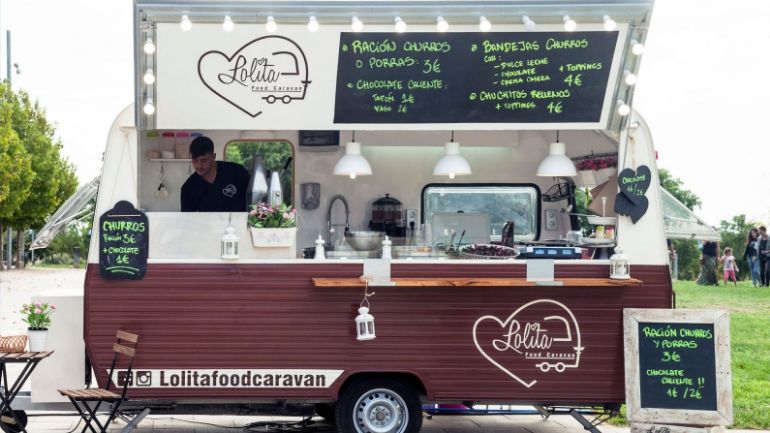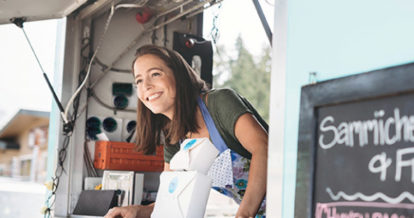It’s your food truck dream, baby, we’re just living in it. Whether you wanna serve deep fried goodness at a country music festival or piping hot coffee to the power suit Wall Street crowd, good food truck design is the foundation on which you can build a successful food truck business.
In this article, you’ll learn everything you need to know about food truck design:
- The permits and licenses you’ll need for your food truck
- How to choose the right vehicle to match your design
- How to fuel your food truck
- How to design the interior of your food truck
- How to decide on food truck mobility
- How to brand the outside of your food truck
- How to access restrooms from your food truck
You can decide to follow these steps in order or use this resource as your food truck design plan. Either way, you should walk away from this article knowing exactly how to start a food truck business and how to create a food truck design action plan that will help you build your empire on wheels.
Licenses and Permits for Food Trucks
We hate to kick this off with boring ol’ bureaucracy, but you should be thinking about licenses and permits before you even begin to think about your food truck design.
Local regulations for food trucks will affect every design choice you make. When asked what they wish they’d known when they launched their business, most food truck owners will talk about licenses and permits.
Food truck regulations vary from place to place, but here are some crucial permits you should definitely know about:
- Emissions guidelines
- Proximity restrictions
- Parking permits
- Staffing regulations
Before you begin to design your food truck, make sure you know which licenses you need to run your food truck in your city and state/province. You can take your design plans to your local government for review before you execute them. This can be an annoying step, but one that could save you from hefty fines and redesigns further down the road.
Before Designing Your Food Truck
You’ll want to design your food truck layout so it uses space efficiently, keeps your staff happy, and enables your customer experience.
When you start thinking about food truck design, make sure you have answers to the following three questions:
- What’s on my menu?
- What equipment do I need?
- What’s my budget?
Now apply your answers to the following six steps of food truck design.

1. Choosing the Right Vehicle for Your Food Truck
First, a note: some experts think the truck should come before the design. Others think you should design your layout before you buy the truck.
There is no wrong answer here, but you may want to consider the latter over the former. When you envision your design before you buy your truck, you’ll be purchasing your truck based on the amount of space you need for your equipment, inventory, and staff.
Be ready to tweak your design once you actually have your food truck, but know that developing a solid vision for your design will help focus your efforts.
Lucky for you, we’ve come a long way since the first food truck – so you’ve got tons of options when shopping for the food truck of your dreams. Choosing the right vehicle for your business will likely be your first, if not your biggest, decision.
Consider the following while selecting your food truck:
- Size: Bigger means more space for equipment, but smaller trucks are easier to maneuver and park.
- Look: Match your food truck to your brand.
- New vs. retrofitted: Do you dream of starting from scratch with your food truck build, or is retrofitting a vintage beauty more your style?
- Fuel: Electric cars are a sustainable and cost effective option if you have access to charging stations and don’t plan on covering long distances. Fuel and biodiesel are great options for anyone planning to be in more remote areas like festivals.
Once you make your choice, you can start daydreaming about interiors and equipment, since you’ll have actual measurements to work with. Your truck is liable to be your most important asset and your biggest pain in the butt, so choose wisely according to your needs.
2. Running Your Food Truck
Food trucks don’t run on hopes and dreams. Powering your food truck can get expensive, but there are loads of ways to run a sustainable – and affordable – business.
Know the answers to these questions before you choose a power source for your food truck:
- How much voltage will my equipment require?
- What are the emissions guidelines and regulations in my area?
- Will my power source affect my insurance rates?
Generators come in lots of different shapes and sizes. Running refrigerators, drink fountains, freezers, fryers, ovens, and lights all at once requires a lot of power. Investing in a good commercial generator will allow you to do all of that with the push of a button.
Generators pack a lot of punch, but they also produce a lot of carbon monoxide and heat. Make sure your generators are professionally installed with proper ventilation and away from anything flammable.
Solar panels are a great way to run your food truck and save some money. While solar panels can feel like a hefty investment up front, they’ll pay for themselves in no time as long as you’re in a place with enough sun to justify the expense.
The panels themselves can be placed on your roof. This can be cumbersome if you’re hoping to use that area for storage and ventilation, but the panels are flat and generally won’t take away from the aesthetic of your truck.
As a bonus, solar panels will give you bragging rights about the sustainability of your truck – which can help you when you’re marketing your truck.
Fuel-powered generators won’t leave you stuck without power on a rainy week, but they do cause emissions and can be costly to run. If you’re able to source a generator that runs on biodiesel, you’re laughing. Biodiesel engines can run on vegetable oil, so if you’re running a deep fryer, consider this option number one!
You have the option to connect your generator to its own dedicated tank or pull from your vehicle’s on board fuel tank to save space. Just don’t get stuck without enough fuel to peel out as that mob of hangry music fest goers realize you’re out of donuts.
(Check out this food truck owner who is running his business entirely on solar power and … wait for it … recycled vegetable oil from his own kitchen. Does it get any more sustainable than that?)

3. Your Food Truck Layout
Without a truck and power you wouldn’t even have a business in the first place – but your food truck layout is where the planning gets real. Your food truck’s interior design will have the biggest impact on your staff and your customers, which will have the biggest impact on your business overall.
The kitchen is where the magic happens. A poorly designed food truck kitchen can make staff feel like Rick Moranis in his lesser known flick, Honey I Shrunk the Kitchen.
Your kitchen layout will depend entirely on your menu, but it should also prioritize your staff’s safety, happiness, and efficiency.
Here’s what you’ll need to include in your food truck kitchen blueprint:
- Durable, non-slip, inflammable floors like commercial grade laminate or vinyl
- Proper ventilation in the form of a hood fan and roof vent, with additional windows if you can swing it
- Room for staff to move around freely while carrying hot pots and pans
- Easy access to inventory and ease of transition between workstations
- Emergency exits
Visualize your final product from its arrival to your truck through to its delivery to your customer, and design your kitchen based on that workflow. Your workflow is unique to your food truck, but you can use this list as a basic template to work from in designing your food truck:
- Refrigeration and dry storage
- Food preparation area
- Grills, deep fryers, ovens, and stove tops
- Plating area
- Serving area
- Clean up station
- Handwashing station as per your local regulations
Outsource your food truck design
Doing it yourself to cut costs is tempting, but don’t become the next Pinterest vs. reality meme. Outsourcing your food truck design can save you time, money, and headaches in the long run by ensuring it will be done right the first time.
Meet some food truck designers doing cool things:
New York City
Shanghai Mobile Kitchen Solutions started out providing cooking equipment specifically designed for Chinese cuisine. They’ve since expanded to provide equipment for all commercial kitchens, including mobile.
Chicago
Mr. Kustom is a Chicago based company specializing in building custom food trucks. According to their website, they are aware of all local food truck regulations and will build your food truck with those in mind. They also handle lighting and wireless internet setup, as well as vinyl wrapping.
Austin
ATX Food Truck Builder are a family owned operation offering custom builds as well as print and design services. As a bonus, they do service calls for electric, plumbing, and a number of other issues you might face as a food truck owner.
Toronto
Unique Food Truck is a one stop shop for everything related to building and designing your food truck inside and out.
Pacific Northwest
Northwest Mobile Kitchens (NMK) custom builds high quality food trucks, catering trailers, and more. You can check out some of the food trucks they’ve designed here.
Anywhere
Apex Specialty Vehicles are industry leaders in food truck design and offer their services across the U.S. and Canada. Their online portfolio speaks for itself.

The service window is your only point of contact with your customers, and space here – just like everywhere else – is at a premium. The amount of counter space you require will depend on the type of food you’re serving, but regardless of your menu, you don’t want your POS system taking up half the space. TouchBistro offers an iPad POS system that will free up space at your service counter and improve workflow.
Ambiance is crucial to your customer’s enjoyment of your food truck. An awning over your service counter not only protects customers from the elements, but also makes them feel like they’ve stepped inside.
Hang string lights between your truck and a nearby tree or portable post to entice passersby. Well designed, legible, and brand-relevant menu boards also go a long way to enhance customer experience.

Need to get the word out about your food truck?
4. Food Truck Mobility
Despite the inherent implication of mobility in the name, many food trucks stay in one place year round. Remember that you have the option to stay put or move around.
Both options come with their own advantages, but you should know that your decision will directly affect your design choices. Here’s how.

Option A: Staying put
Some stationary food trucks offer options like outdoor seating, reusable dishware, and outdoor public restrooms. The drawback is that – much like with brick & mortar restaurants – you’re relying on people coming to you rather than following the action.
There are several ways choosing to stay put will affect your design choices:
- Smaller service window: You may opt for a model where people order at the counter and their food is brought out to them, which cuts back on the space you need for your service window. This feature will give you more space for things like food prep and cooking.
- Intricate decor: Your exterior light fixtures and menu boards can be a little more sophisticated since you won’t be tearing them down and packing them up at the end of your work day.
- Less storage space for dishware: Reusable dishware requires less storage space than their disposable counterparts. Note, however, that you may require an extra staff person to man the cleaning station and ensure you don’t run out of cups or plates in the middle of service.
Option B: Hitting the road
Going mobile means you can go where the people are, which is half the battle of restaurant ownership. And if you get your truck listed on the right food truck apps, you might even have people coming to you.
The downsides to mobility are mostly related to logistics and awareness of changing regulations based on where you’re parked that day.
Also don’t forget the need to tear down and drive away every night.
Here’s how mobility will affect your design choices:

- Storage space: Moving around from place to place means you’re unlikely to have a seating area, and most people will be taking their food to go. Plan for a fair amount of your storage space to be devoted to disposable dishware, cutlery, and takeout containers.
- Equipment load: The weight of the equipment on board your truck directly impacts fuel efficiency and puts extra wear and tear on your truck’s suspension and brakes. If you plan to cover a lot of miles, aim to source lightweight equipment and supplies.
- Material tear down: Anything you plan to set up outside your truck – think sandwich boards, string lights, garbage cans, etc. – needs to be easy to set up and tear down, and should have its own designated storage area on board.
- Emergency equipment: The more you drive, the higher your risk of breaking down. Make sure you have emergency car maintenance equipment onboard, like a jack, spare tire, extra fuses, booster cables, and a basic toolkit.
5. Branding Your Food Truck
Food truck marketing is a world of its own, one we highly recommend you drive – excuse us, dive – into.
The difference between marketing a brick & mortar restaurant versus a food truck is that in the one instance you’re attempting to drive people to your restaurant, and in the next instance you’re attempting to drive to your customers.
An attractive exterior goes a long way to attracting people to your truck. Here are some options to consider when you’re branding the exterior of your food truck.
Vinyl wraps

Vinyl wraps are the most common method of designing food truck exteriors, and for good reason. Despite being pricey and difficult to install (there are people you can pay to do this for you), they’re great for building a strong brand. You can upload your logo and other graphic design elements related to your brand directly to the printer, which creates a firm foundation for a consistent brand identity.
Hand painting
The main alternative to vinyl wrapping your truck is hand painting it. This option is significantly cheaper and a lot more DIY friendly. The downside is that it may be more difficult to achieve a consistent brand, as your painted logo is unlikely to look the same as the one on your website. But hiring a local artist to paint your truck is great way to increase word of mouth about your business. You’re also more likely to end up with a design that makes you stand out from the crowd.
A little of each

Rather than having your whole truck wrapped, you can opt for vinyl decals of your logo and other graphics to cut costs without compromising your brand identity.
6. Food Truck Bathrooms
To throne or not to throne? Is that the question? The answer will depend on a few things:
- Regulations in your area
- The size of your truck
- Where you’re planning to sell food
- Personal preference
While restroom regulations vary from city to city, most places require you to be within a certain distance from a washroom with soap and running water. Many cities also have limits on how long you can leave your truck unattended, even if it’s shuttered.
If you have the space, a toilet on board can increase productivity if it means your staff don’t have to go offsite to use the washroom. That being said, dealing with grey water tanks or composting toilets can significantly add to the amount of time you’ll spend on cleaning and maintaining your food truck.

Need to get the word out about your food truck?
The food truck industry is growing in leaps and bounds, and it isn’t hard to see why. Whether you’re taking your dream of restaurant ownership on the road or adding a mobile element to your existing brand, it’s a great time to get in on the action.
A well thought out plan is a solid foundation on which to begin building your business, and that’s what food truck design is all about. There are no limits to how many changes and alterations you can make during the design phase. Keep reconfiguring things until you land on a model that makes the most sense for you.
Don’t be shy to reach out to the owners of your favorite food trucks to ask them what they’d do differently given another chance. Pick and choose your favorite and least favorite elements from other people’s trucks and incorporate or omit those from your design.
No matter how overwhelming things may become in the process, remember to enjoy the ride and keep on truckin’!

Need to get the word out about your food truck?
Free job application template for restaurants
Sign up for our free weekly TouchBistro Newsletter







